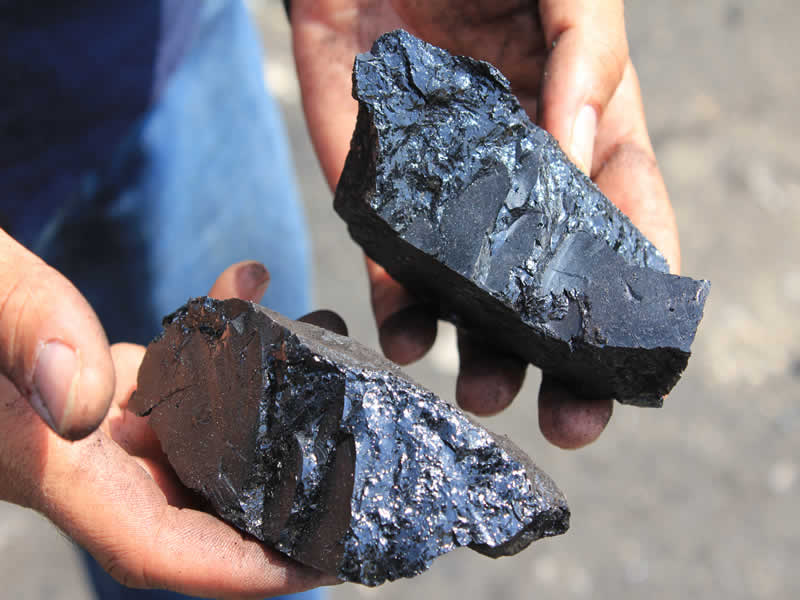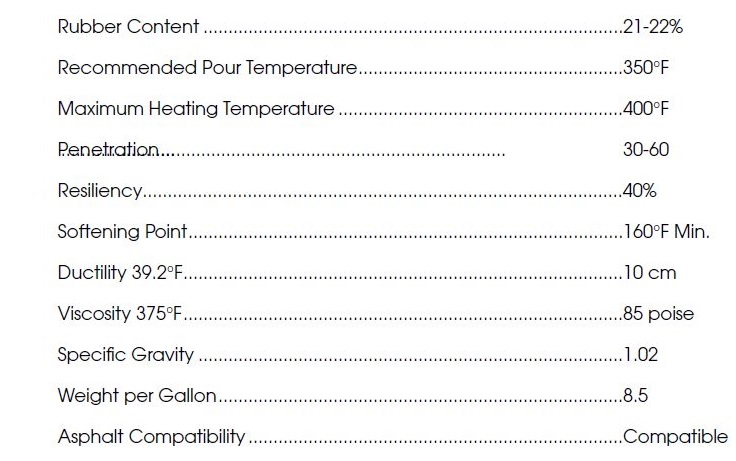
Construction

Gilsonite in construction
Many construction processes are controlled by comparing the desired product, conceived during design, to the product produced during construction. The asphalt pavement construction process is often controlled in this manner. Control is often based on testing of components and assemblies of materials, the construction process, and the finished asphalt pavement. The success of the asphalt pavement construction project is usually judged based on how well test results produced during construction compare with criteria considered representing the desired product conceived during design.
Gilsonite has been the subject of exhaustive study to improve characteristics for use in paving. Various properties of asphalt are manipulated to produce a product that has the appropriate wear properties, rut resistance, fatigue and low temperature cracking resistance, adhesion strength, viscosity and pour point. Rut resistance is resistance to longitudinal surface depressions in the wheel paths. Adhesion strength is the maximum adhesion strength of the joint sealant and the joint reservoir, including but not limited to, between the aggregate and the binder.
Crack sealer produced by the blend of bitumen with SBS, Gilsonite, rubber process oil, crumb rubber in special temperature and pressure and using as sealing cracks and joints in the asphalt pavement and parking also cement pavement. It is used to seal expansion and longitudinal and transverse crack and construction joints between concrete and asphaltic shoulder. Gilsonite is one of the environmentally friendly products to repair and seal the asphalt. Gilsonite joint sealer and crack sealer is widely used in the world. The preferred embodiment of the invention employs a roofing adhesive or cement for filling the parking lot crack, either asphalt or concrete after it has been thoroughly cleaned either with air or water. The adhesive is preferably a modified bitumen rubber asphalt normally used for bonding roofing materials.

The adhesive is mixed with an SBS, crumb rubber, gilsonite and asphalt oil as asphalt roof coating which makes the mixture form a water impermeable shield. The pliability and time to set depends on the temperature and can be adjusted by adding mineral spirits or airing the adhesive. The crack is filled with the adhesive mixture which is then exposed to air for 15 to 20 minutes. A formed cured cap is then placed on top of the crack and the adhesive mixture. Other cap materials are available such as asphalt oil. The cured cap provides a durable surface that will withstand vehicular traffic while protecting the curing adhesive. Although the adhesive mixture sets in 15-20 minutes, it takes days to fully cure. The adhesive eventually fully cures forming a water-impermeable shield in the crack that can withstand vehicular traffic even though the cap may gradually deteriorate from traffic. The preferred method creates a water-tight shield that lasts substantially longer than current methods conventional pavement patching materials. It is well known that paved surfaces, such as roadways, sidewalks, driveways, tennis courts and the like, can develop cracks, which necessitate repair. These cracks often develop over time, but can also appear in new paved surfaces. Asphalt surfaces, in particular, are susceptible to developing cracks in regions that have extreme weather conditions or that have large temperature fluctuations. It is desirable to repair these cracks to preserve the longevity of the entire asphalt surface as well as to prevent damage or injury to those using the surface. One way to eliminate cracks from paved surfaces is to tear it up and replace the entire surface. This process is extremely expensive. It is also not practical to replace the entire surface, which has many more years of useful life because cracks have formed in a small portion of the surface.
The unique properties of Gilsonite make it an integral part of the production of asphalt-impregnated fiberboard, known as concrete expansion joints.
Asphalt-impregnated fiberboard made with RAHA Gilsonite has the industry’s highest asphalt content, so it always meets the ASTM Standard. For concrete expansion joints, we provide a special grade of Gilsonite that is sized so no additional grinding is required for introduction to a slurry tank. That means higher quality, streamlined processes, and better project integrity.
The unique properties of Gilsonite also enable faster production. Because Gilsonite is naturally hydrophobic, it speeds the release of water as the mat is formed. When the board has been heating pressed, Gilsonite’s adhesive properties bind the fibers together, making a stronger board.
- 98% Asphalt under ASTM testing
- Naturally hydrophobic for faster mat formation
- Excellent bonding for higher strength in finished board
Road pavement seal by Gilsonite
Instead of ripping up an entire paved surface, various less expensive methods have been employed to repair cracks that may develop in these surfaces. One known process is to fill the cracks with an asphalt sealer. While this often serves to fill the cracks at least temporarily, the utilization of current asphalt sealers to repair cracks suffers from some significant disadvantages. Initially, Gilsonite asphalt sealers are susceptible to melting when subjected to high temperatures, which results in the sealer flowing away from a crack filling position. For example, when the asphalt sealer heats up, it becomes softer and can be squeezed, such as by a vehicle passing thereover, so that it no longer properly fills the crack. Additionally, because of their composition, current sealers can be slippery, which is undesirable. As existing asphalt sealers have very limited durability when serving to fill cracks, if the sealer no longer serves to fill the crack, additional crack repair services are required. Accordingly, existing crack repair methods and systems are costly, both in terms of material and labor. In some instances where the crack is deep enough, a grout material, such as a mortar or cement, is used to assist in filling these cracks. In these instances, the grout material is placed in the crack and allowed to harden. Thereafter, the asphalt sealer is placed in the crack over top of the grout material to completely fill the crack and level out the paved surface. This can also create durability issues in that existing grout fillers that are used in crack repair applications often have significant shrinkage issues.
Thus, while an asphalt sealer used to help fill a crack may initially be level with the surface being repaired when the grout material shrinks, the asphalt sealer will drop into the crack as the level of the grout material recedes. The asphalt sealer thus is no longer flush with the upper paved surface and often falls into the crack itself. In an effort to address some of these deficiencies, aggregates such as sand or limestone, were added to the asphalt sealer to provide it with more substance. However, these efforts were unsuccessful as these aggregates would release from the sealer, such as when contacted, and they would therefore eventually fail. Thus, while they provided some increased durability, they ultimately suffer from the same disadvantages as asphalt sealers without an aggregate. It would, therefore, be advantageous to provide an improved asphalt sealer for paved surfaces that overcomes these disadvantages. It would also be advantageous to provide an improved crack repair system that overcomes the failings of current systems.
